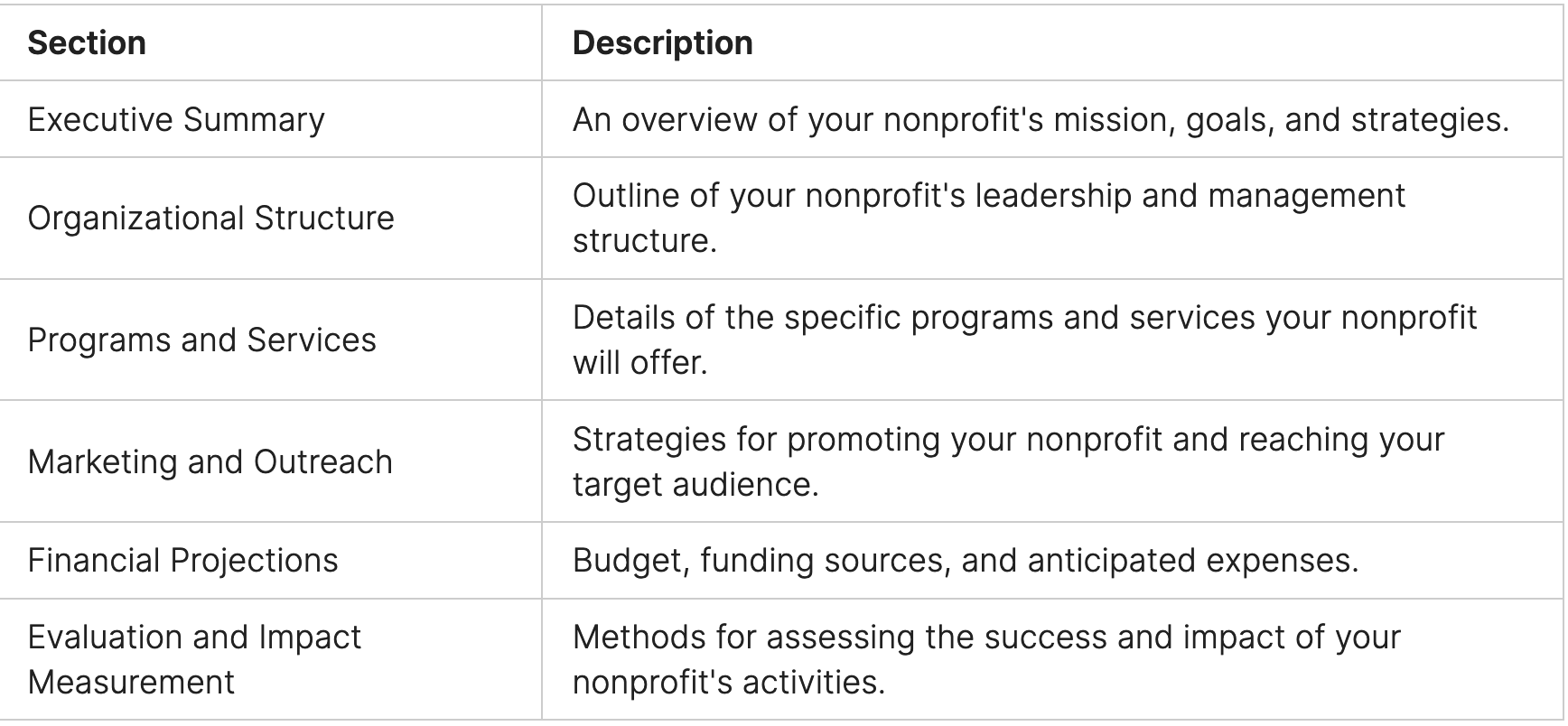California Nonprofits: Building a nonprofit

If you're passionate about making a difference and serving your community, this article is here to help. We will walk you through each process step, from planning to successful operation. Let's get started on your journey to creating a nonprofit that can have a lasting impact!
Key Takeaways:
- Establishing a nonprofit in California requires careful planning and adherence to legal requirements.
- Key steps include defining your mission statement, conducting strategic planning, and creating a business plan.
- Forming your nonprofit involves preparing articles of incorporation, drafting bylaws, and filing with state agencies.
- Registering your nonprofit with the state of California requires submitting the necessary forms and obtaining an Employer Identification Number (EIN).
- Fundraising and grant writing are essential for sustaining your nonprofit and securing necessary funding.
Understanding Nonprofit Organizations in California
Before diving into the steps of building a nonprofit, it's crucial to understand the unique characteristics of nonprofit organizations in California. These organizations play a key role in addressing various social issues and making a positive impact in their communities. In this section, we'll delve into the legal requirements, charitable purposes, and benefits of forming a nonprofit in California.
California laws provide a framework for the establishment and regulation of nonprofit organizations. These laws ensure that nonprofits operate following specific rules and regulations, promoting transparency and accountability. To successfully navigate these legal requirements, it's vital to understand the obligations and responsibilities that come with running a nonprofit in California.
In addition to legal compliance, nonprofit organizations in California are expected to have a clear and defined charitable purpose. This purpose serves as the foundation for the organization's mission and activities, guiding its focus and impact. By clearly articulating their charitable purpose, nonprofits can effectively communicate their values to stakeholders and attract support from donors, volunteers, and the broader community.
"A nonprofit organization is not just about earning profits; it is about making a difference. By adhering to California laws and establishing a charitable purpose, nonprofits can create lasting change and contribute to the betterment of society."
Forming a nonprofit in California offers several benefits beyond legal compliance and a clear purpose. Nonprofits are eligible for certain tax exemptions, allowing them to reinvest their resources for the greater good. Additionally, they have access to grants, foundations, and philanthropic organizations that specifically support nonprofit causes. These benefits help nonprofits thrive and expand their impact, ensuring sustainability in their mission to serve the community.
As you embark on your journey to build a nonprofit organization in California, remember to familiarize yourself with the legal requirements, define a strong charitable purpose, and leverage the benefits that come with forming a nonprofit. Understanding these aspects will lay a solid foundation for your nonprofit's success and enable you to make a meaningful difference in the lives of those you aim to serve.
Planning Your Nonprofit Venture

A solid foundation is crucial for any nonprofit venture. It starts with a clear mission statement that defines your organization's purpose and sets the stage for strategic planning. By effectively planning your nonprofit venture, you can maximize your impact and ensure long-term success.
Defining Your Mission Statement
A mission statement outlines the overarching purpose of your nonprofit. It serves as a guiding principle that helps define your organization's goals and activities. When crafting your mission statement, consider the following:
- Succinctness: Keep it concise and focused, ensuring it accurately captures the essence of your nonprofit venture.
- Clarity: Communicate the problem you aim to address and the solutions you seek to provide.
- Inclusivity: Ensure your mission statement reflects the diversity of the communities you serve and is inclusive of all stakeholders.
Here's an example of a well-crafted mission statement:
"To empower underprivileged youth through education and mentorship programs, providing them with the tools and opportunities to achieve their full potential."
Conducting Strategic Planning
Strategic planning helps you develop a roadmap for achieving your nonprofit's goals. It involves a systematic analysis of your organization's strengths, weaknesses, opportunities, and threats (SWOT analysis), as well as setting specific objectives and identifying the resources needed to accomplish them.
Consider these steps when conducting strategic planning:
- Assess your organization: Evaluate your nonprofit's current state, identifying internal strengths and weaknesses.
- Define your goals: Determine the desired outcomes and impact you want to achieve in alignment with your mission statement.
- Establish strategies: Devise specific action plans and strategies to reach your goals, considering the resources and partnerships required.
- Monitor and adjust: Regularly review your progress toward your goals and make adjustments as needed to stay on track.
Creating a Business Plan
A well-structured business plan is essential for attracting support and funding for your nonprofit venture. It outlines your organization's operations, financial projections, and marketing strategies. When creating a business plan, include the following key sections:
- Executive summary: Provide an overview of your nonprofit's mission, goals, and strategies.
- Organizational structure: Outline your nonprofit's leadership and management structure.
- Programs and services: Detail the specific programs and services you plan to offer.
- Marketing and outreach: Describe your strategies for promoting your nonprofit and reaching your target audience.
- Financial projections: Present your budget, funding sources, and anticipated expenses.
- Evaluation and impact measurement: Explain how you will assess the success and impact of your nonprofit's activities.

Forming Your California Nonprofit
Now that you have carefully planned your nonprofit venture, it's time to take the important step of officially forming your organization. In this section, we'll guide you through the necessary steps to establish your nonprofit, ensuring that you meet all legal requirements and lay a solid foundation for your future operations.
Key Steps:
- Preparing Articles of Incorporation
- Drafting Bylaws
- Filing with the Appropriate State Agencies
Let's take a closer look at each of these steps:
1. Preparing Articles of Incorporation
The articles of incorporation are a legal document that establishes your nonprofit as a separate legal entity. This document outlines important information such as the organization's name, purpose, governance structure, and initial board members.
When preparing your articles of incorporation, you will need to include:
- The official name and address of your nonprofit
- A clear statement of the organization's purpose and activities
- Information about the initial board of directors
- A dissolution clause, which outlines the procedures for winding up the organization in the event of closure
It's important to consult with an attorney or legal expert familiar with nonprofit law in California to ensure that your articles of incorporation comply with all necessary regulations.
2. Drafting Bylaws
Bylaws serve as the internal rules and regulations that govern your nonprofit organization. They outline how the organization will be operated, including procedures for electing officers, conducting meetings, and making decisions.
When drafting your bylaws, you should consider including:
- The organization's purpose and mission
- The structure and responsibilities of the board of directors
- The process for electing officers and board members
- The procedures for conducting meetings and making decisions
- Financial policies and guidelines
Like the articles of incorporation, it's recommended to seek legal advice to ensure that your bylaws align with California nonprofit laws and regulations.
3. Filing with the Appropriate State Agencies
Once you have prepared your articles of incorporation and drafted your bylaws, it's time to file the necessary paperwork with the appropriate state agencies in California. This typically involves submitting your documents to the California Secretary of State.
When filing, you will need to pay a fee and provide the following information:
- Completed and signed articles of incorporation
- A copy of your organization's bylaws
- Any additional forms or documents required by the state
After reviewing your submission, the California Secretary of State will issue a Certificate of Incorporation, officially recognizing your nonprofit as a legal entity.
Forming a nonprofit organization requires careful attention to legal requirements and careful consideration of your organization's structure and goals. Taking the time to prepare articles of incorporation, draft bylaws, and file the necessary paperwork will help ensure that your nonprofit is formed correctly and ready to make a positive impact in your community.
Next, we will explore the crucial step of registering your nonprofit with the state of California, which is essential to gain recognition and access important benefits.

Registering Your Nonprofit with the State of California
Once your nonprofit is formed, it is important to complete the registration process with the state of California. Registering your nonprofit ensures that you comply with all legal requirements and can operate as an official nonprofit organization. In this section, we will guide you through the registration process step by step, highlighting the necessary forms and procedures.
Step 1: Decide on a Name
Search through the California Secretary of State - Business Programs Division
Step 2: Decide California's Nonprofit Corporate structure
California offers four corporate structures for nonprofit corporations.
- Religious corporations are primarily or exclusively for religious purposes such as a church.
- Public benefit corporations are those seeking IRS exemptions 501(c)(3) or 501(c)(4) and/or similar California state tax exemptions. These organizations are organized for charitable purposes, act as a civic league, or as a social welfare organization.
- Mutual benefit corporations are other nonprofits that may or may not seek IRS and California tax exemptions. A mutual benefit corporation may not create the impression that the corporate purpose is public, charitable, or religious, nor create the impression that it is a charitable foundation.
- Mutual benefit common interest development (CID) corporations are formed under the Davis-Stirling Common Interest Development Act to manage a common interest development (for example, a homeowner’s association). Common interest development associations can also be unincorporated.
Step 3: Employer Identification Number (EIN)
As well as registering with the California Secretary of State, you will also need to obtain an Employer Identification Number (EIN) from the Internal Revenue Service (IRS). The EIN is a unique identifier for your nonprofit and is necessary for various purposes, including opening a bank account and applying for tax-exempt status. You can apply for an EIN online through the IRS website.
Step 4: Filing Fees
Get California State Tax Identification.
File 990 forms, annually.
Apply for 501c(3) status.
Apply for state exemptions as a nonprofit

Fundraising and Grant Writing for California Nonprofits
To sustain your nonprofit's operations and fulfill your mission, active engagement in fundraising and grant writing is essential. Securing funding through grants and donations is important for supporting the programs and initiatives of your organization. Here are some tips and strategies to help you succeed in fundraising and grant application processes for California nonprofits:
1. Develop an Effective Fundraising Strategy
Creating a well-defined fundraising strategy is the key to success. Identify your target audience, set clear fundraising goals, and choose the most suitable fundraising methods for your organization. Whether organizing events, launching online campaigns, or partnering with local businesses, a strategic approach will maximize your chances of success.
2. Build Relationships with Donors and Supporters
Nurturing relationships with donors and supporters is crucial for long-term sustainability. Engage with your donors regularly, express gratitude for their contributions, and keep them updated on the impact of their support. Cultivating strong relationships will encourage continued support, potentially leading to new funding opportunities.
3. Research and Apply for Grants
There are numerous grants available for nonprofit organizations in California. Take the time to research and identify relevant grants that align with your mission and programs. Pay close attention to the eligibility criteria, requirements, and deadlines. Craft compelling grant proposals that clearly articulate your organization's goals, strategies, and expected outcomes.
4. Develop a Case for Support
A compelling case for support is crucial to convince potential donors and grantors to invest in your nonprofit. Communicate your organization's impact, highlight the need for your programs, and demonstrate how your work aligns with the interests and values of your target funders. Use storytelling techniques and real-life examples to engage your audience emotionally and inspire support.
5. Cultivate Diverse Funding Sources
Relying on a single funding source can be risky for your nonprofit's sustainability. Diversify your funding by actively seeking different sources, such as individual donors, corporate sponsorships, foundation grants, and government contracts. This will provide stability and flexibility in times of economic uncertainty.
6. Stay Informed about Grant Opportunities
Grant opportunities for nonprofits are ever-evolving. Stay updated on grant announcements, funding cycles, and changes in grant requirements. Regularly check the websites of funding organizations, subscribe to grant newsletters, and network with professionals in the nonprofit sector to stay informed and ahead of funding opportunities.
7. Measure and Communicate Your Impact
Donors and grantors want to see the impact of their investments. Develop a robust system to measure and track the outcomes and impact of your programs. Regularly communicate these results to your supporters through impact reports and success stories. Demonstrating the effectiveness of your work will enhance your credibility and attract more funding.
Remember, successful fundraising and grant writing requires perseverance, creativity, and a genuine passion for your organization's mission. By implementing these strategies and continuously refining your approach, your California nonprofit can increase its chances of securing the necessary funding to achieve its goals.
Compliance and Reporting Obligations for California Nonprofits
As a nonprofit organization operating in California, it is essential to understand and fulfill your compliance and reporting obligations. By adhering to these requirements, you can maintain transparency, and accountability, and uphold the trust of your stakeholders.
Financial Reporting
Nonprofits are also required to comply with financial reporting standards. You must maintain accurate and up-to-date financial records, prepare financial statements, and follow Generally Accepted Accounting Principles (GAAP). These reports provide transparency regarding your organization's financial activities and help demonstrate your commitment to fiscal responsibility.
Maintaining Tax-Exempt Status
For nonprofits that have obtained tax-exempt status, it is crucial to meet the ongoing requirements set by the Internal Revenue Service (IRS) to maintain this status. This includes filing annual information returns, known as Form 990, to report your organization's financial and operational details.
Remember: Failing to comply with your compliance and reporting obligations can result in penalties, loss of tax-exempt status, and damage to your nonprofit's reputation. It's important to stay informed and take these obligations seriously.
By fulfilling your compliance and reporting obligations, you demonstrate your commitment to operating responsibly and ethically. Compliance not only ensures legal adherence but also helps build trust and credibility among donors, volunteers, and other stakeholders.
Building and Managing Your Nonprofit Team
Your nonprofit's success relies on the people you work with. Building a strong and dedicated team is essential for achieving your organization's mission. In this section, we'll discuss effective strategies for recruiting and managing volunteers, as well as establishing an effective board of directors.
Recruiting Volunteers
Volunteers play a vital role in nonprofit organizations. They bring diverse skills, passion, and a shared commitment to your cause. Here are some strategies to attract volunteers:
- Define volunteer roles and responsibilities clearly, ensuring they align with your organization's goals.
- Utilize various channels to advertise volunteer opportunities, such as social media, community bulletin boards, and local newspapers.
- Engage with community organizations, schools, and universities to spread the word about your nonprofit and volunteer opportunities.
Show appreciation for your volunteers through recognition events, volunteer spotlights, and thank-you notes.
Establishing an Effective Board of Directors
Your board of directors provides leadership, guidance, and oversight to your nonprofit organization. A well-structured board can bring diverse expertise and networks to help drive your mission forward. Here are key steps to establish an effective board:
- Identify individuals who are passionate about your cause and have relevant skills and experience.
- Create a clear board recruitment process, including job descriptions, nomination forms, and interview protocols.
- Ensure diversity and inclusion within your board, representing different backgrounds and perspectives.
- Offer board orientation and ongoing training to ensure members understand their roles and responsibilities.
- Establish regular board meetings to discuss organizational strategies, and financial matters, and monitor progress.
Remember, a collaborative and effective board of directors can be a valuable asset to your nonprofit team, providing strategic guidance and support to help achieve your organization's goals.
By implementing effective strategies for volunteer recruitment and board management, you can build a strong and dedicated team that will contribute to the success of your nonprofit organization.
Online Presence: Building a Digital Foundation
Establishing a strong online presence is essential in today's digital age. Here are some strategies to consider:
- Create a visually appealing and user-friendly website: Your website is the hub of your online presence. Make sure it reflects your nonprofit's mission, showcases your impact, and makes it easy for visitors to take action.
- Optimize your website for search engines: Implementing search engine optimization (SEO) techniques will help your website rank higher in search results and attract more organic traffic.
- Engage in content marketing: Produce valuable and relevant content, such as blog posts, infographics, and videos, to educate and inspire your audience.
- Engage with your audience on social media: Utilize social media platforms to share updates, success stories, and impact metrics. Interact with your followers, respond to comments, and use hashtags to expand your reach.
Community Outreach: Connecting with Your Local Community
Beyond the digital realm, community outreach is a powerful way to promote your nonprofit and build meaningful connections. Consider the following strategies:
- Collaborate with local businesses and organizations: Partnering with like-minded businesses and organizations can help you expand your reach and tap into their networks.
- Participate in community events and fairs: Set up a booth, host a workshop, or participate in local events to engage directly with community members and raise awareness about your nonprofit.
- Seek media coverage: Reach out to local newspapers, TV stations, and radio stations to share your nonprofit's story. A well-crafted press release or a compelling media pitch can help you secure coverage.
- Host fundraising events: Organize creative and engaging fundraising events that not only raise funds but also generate buzz and awareness for your cause.
Collaborations: Strengthening Impact through Partnerships
Collaborating with other nonprofits, businesses, and community organizations can amplify your impact and expand your reach. Consider the following collaboration opportunities:
- Partner with complementary nonprofits: Identify nonprofits whose missions align with yours and explore opportunities for joint initiatives, shared events, or cross-promotion. This is called collective impact.
- Engage with corporate sponsors: Build relationships with businesses that have corporate social responsibility programs. Seek partnerships for sponsorships, employee volunteering, or cause marketing campaigns.
- Join local networks and associations: Connect with other nonprofit professionals and leaders through local networks and associations. Attend networking events and share knowledge and resources.
By utilizing these nonprofit promotion and marketing strategies, including establishing an online presence, engaging in community outreach, and fostering collaborations, your California nonprofit can reach new heights and make a lasting impact in the community.
Now is the time to take the next step and start transforming your vision into reality. Begin gathering your team, drafting your plans, and reaching out to potential supporters. Together, we can build a stronger, more compassionate California.




